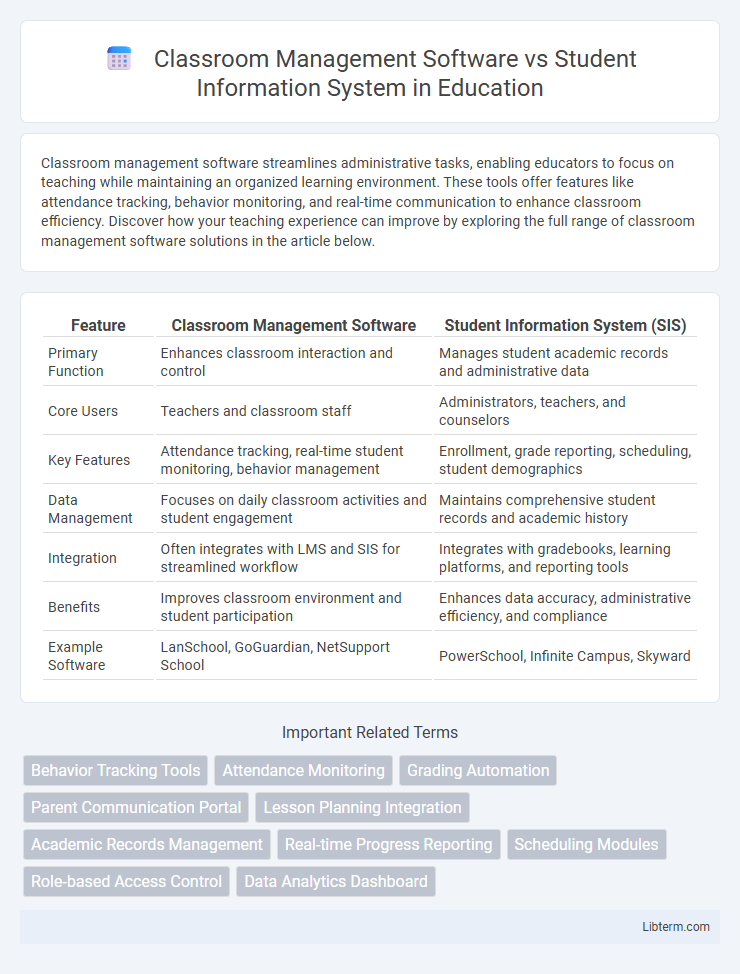Classroom management software streamlines administrative tasks, enabling educators to focus on teaching while maintaining an organized learning environment. These tools offer features like attendance tracking, behavior monitoring, and real-time communication to enhance classroom efficiency. Discover how your teaching experience can improve by exploring the full range of classroom management software solutions in the article below.
Table of Comparison
| Feature | Classroom Management Software | Student Information System (SIS) |
|---|---|---|
| Primary Function | Enhances classroom interaction and control | Manages student academic records and administrative data |
| Core Users | Teachers and classroom staff | Administrators, teachers, and counselors |
| Key Features | Attendance tracking, real-time student monitoring, behavior management | Enrollment, grade reporting, scheduling, student demographics |
| Data Management | Focuses on daily classroom activities and student engagement | Maintains comprehensive student records and academic history |
| Integration | Often integrates with LMS and SIS for streamlined workflow | Integrates with gradebooks, learning platforms, and reporting tools |
| Benefits | Improves classroom environment and student participation | Enhances data accuracy, administrative efficiency, and compliance |
| Example Software | LanSchool, GoGuardian, NetSupport School | PowerSchool, Infinite Campus, Skyward |
Introduction to Classroom Management Software and Student Information Systems
Classroom Management Software enables teachers to organize lessons, monitor student activities, and facilitate interactive learning environments through digital tools like attendance tracking and real-time feedback. Student Information Systems centralize administrative data, managing student records, enrollment, grades, and communication between staff and families for streamlined school operations. Integrating both systems enhances educational efficiency by combining instructional management with comprehensive student data oversight.
Core Features of Classroom Management Software
Classroom Management Software offers core features such as real-time student monitoring, interactive lesson delivery, and attendance tracking, enabling teachers to maintain engagement and discipline effectively. It provides tools for screen sharing, activity restrictions, and instant feedback, enhancing classroom control and student participation. Unlike Student Information Systems, which focus on data management and reporting, Classroom Management Software centers on active instructional support and direct classroom interaction.
Key Functions of Student Information Systems
Student Information Systems (SIS) centralize critical educational data, including enrollment records, attendance tracking, grading, and student demographics, enabling efficient administrative management. Unlike classroom management software, which organizes lesson plans and monitors classroom behavior, SIS focuses on maintaining comprehensive student profiles and facilitating communication between parents, teachers, and administrators. Essential functions of SIS also encompass generating academic reports, scheduling courses, and managing transcripts to support institutional compliance and data-driven decision-making.
Comparative Benefits for Teachers
Classroom management software streamlines daily teaching tasks by enabling easy attendance tracking, assignment distribution, and real-time student engagement monitoring, which enhances instructional efficiency. Student Information Systems (SIS) provide comprehensive access to student academic records, grades, and demographic data, supporting data-driven decision-making and personalized learning plans. For teachers, classroom management software offers immediate classroom control and interaction tools, while SIS focuses on long-term academic tracking and administrative reporting, making their combined use complementary for effective educational management.
Impact on Student Engagement and Performance
Classroom Management Software enhances student engagement by providing interactive tools that facilitate real-time collaboration, immediate feedback, and personalized learning experiences, directly boosting academic performance. In contrast, Student Information Systems primarily streamline administrative tasks and data tracking, indirectly supporting student outcomes through improved organization and communication. Integrating both systems creates a comprehensive educational environment that maximizes student involvement and learning effectiveness.
Data Security and Privacy Considerations
Classroom management software prioritizes real-time interaction and behavior tracking, requiring robust encryption and access controls to protect live student data. Student information systems (SIS) handle comprehensive academic and personal records, demanding stringent compliance with FERPA and GDPR regulations to ensure data confidentiality and privacy. Both systems must implement multi-factor authentication and regular security audits to mitigate risks of unauthorized access and data breaches.
Integration with Other Educational Technologies
Classroom management software often prioritizes real-time integration with learning management systems (LMS), digital whiteboards, and communication tools to streamline lesson delivery and student engagement. Student Information Systems (SIS) focus on aggregating data from various educational technologies, such as enrollment platforms, assessment tools, and attendance trackers, to provide comprehensive student analytics. Both systems benefit significantly from seamless integration, enhancing data flow and operational efficiency across educational environments.
Cost and Scalability Factors
Classroom management software typically offers lower initial costs and subscription-based pricing models, making it accessible for small to medium-sized schools, while student information systems (SIS) require a higher upfront investment due to extensive features and integration capabilities tailored for large districts. Scalability favors SIS platforms, which are designed to handle large student populations and complex data management needs, enabling seamless expansion without significant performance loss. Cost-efficiency in classroom management software suits localized implementation, whereas SIS solutions provide long-term savings through centralized administration and comprehensive data consolidation.
Choosing the Right Solution for Your Institution
Classroom Management Software optimizes daily teaching activities by providing tools for attendance, grading, and student engagement tracking, enhancing teacher-student interaction. Student Information Systems centralize administrative data such as enrollment, transcripts, and scheduling, improving institutional data accuracy and reporting. Selecting the right solution requires assessing your institution's primary needs: prioritize Classroom Management Software for instructional efficiency or a Student Information System for comprehensive administrative management.
Future Trends in Educational Technology Systems
Classroom Management Software is evolving with AI-driven analytics to personalize student engagement and optimize instructional strategies. Student Information Systems are integrating blockchain technology to enhance data security and interoperability across educational platforms. Future trends highlight a convergence of these systems, leveraging cloud-based solutions and real-time data synchronization to support adaptive learning environments and comprehensive educational management.
Classroom Management Software Infographic

 libterm.com
libterm.com